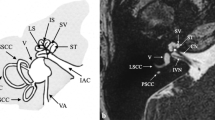Abstract
Objective
To evaluate the accuracy of oblique view extended imaging (OVEI) in locating the position of the fetal conus medullaris.
Methods
One hundred and twenty-two normal fetuses and five counterparts with spinal bifida received prenatal ultrasound examination. The vertebral body at the terminal of the conus medullaris and the coronal section of over five vertebral bodies were reconstructed using OVEI. Development of the nervous system of normal fetuses was assessed at postnatal day 28. For spinal bifida cases, pathological examination was performed.
Results
Among 127 fetuses, the conus medullaris was accurately positioned in 120 (94.0%) cases according to OVEI. OVEI failed to locate the conus medullaris in three healthy fetuses due to obesity of the mother and four cases with spinal bifida due to abnormal fetal position. The conus medullaris was located at L3 or above in 115 healthy fetuses. The conus medullaris was positioned below L4 in five fetuses with spinal bifida, including L5 in two, S1 in two, and S3 in one, which was consistent with the findings of pathological examination.
Conclusions
OVEI can display the 12th rib, T12, and conus medullaris simultaneously. OVEI is applicable to precisely locate the position of the conus medullaris and useful for prenatal evaluation of spinal bifida.









Similar content being viewed by others
References
Hoopmann M, Sonek J, Schramm T, et al. Position of the conus medullaris in fetuses with skeletal dysplasia. Prenat Diagn. 2012;32:1313–7.
Zalel Y, Lehavi O, Aizenstein O, et al. Development of the fetal spinal cord: time of ascendance of the normal conus medullaris as detected by sonography. J Ultrasound Med. 2006;25:1397–401.
Solmaz I, Izci Y, Albayrak B, et al. Tethered cord syndrome in childhood: special emphasis on the surgical technique and review of the literature with our experience. Turk Neurosurg. 2011;21:516–21.
Perlitz Y, Izhaki I, Ben-Ami M. Sonographic evaluation of the fetal conus medullaris at 20 to 24 weeks’ gestation. Prenat Diagn. 2010;30:862–4.
Lei T, Xie HN, Zheng J, et al. Prenatal evaluation of the conus medullaris position in normal fetuses and fetuses with spina bifida occulta using three-dimensional ultrasonography. Prenat Diagn. 2014;34:564–9.
Guide for prenatal ultrasound examination. Chin J Ultrasound Med. 2012;9:571–3.
E ZS, Chen JH, Yu SM, et al. Study on ultrasonography of fetal spinal cord in late pregnancy. Chin J Med Imaging Technol. 2004;20:62–3.
Sohaey R, Oh KY, Kennedy AM, et al. Prenatal diagnosis of tethered spinal cord. Ultrasound Q. 2009;25:83–7.
Beek FJ, van Leeuwen MS, Bax NM, et al. A method for sonographic counting of the lower vertebral bodies in newborns and in fants. AJNR Am J Neuroradiol. 1994;15:445–9.
Hajnovic L, Tranka J. Tethered spinal cord syndrome-the importance of time for outcom. Eur J Pediatr Surg. 2007;17:190–3.
Widjaja E, Whitby EH, Paley MN, et al. Normal fetal lumbar spine on postmortem MR imaging. AJR Am J Neuroradiol. 2006;27:553–9.
Huang YL, Wong AM, Liu HL, et al. Fetal magnetic resonance imaging of normal spinal cord: evaluating cord visualization and conus medullaris position by T2-weighted sequences. Biomed J. 2014;37:232–6.
Blas D. Fetal evaluation of spine dysraphism. Pediatri Radiol. 2010;40:1029–37.
Yamada S, Lonser RR. Adult tethered cord syndrome. J Spinal Disord. 2000;13:319–23.
Bui CJ, Tubbs RS, Oakes WJ. Tethered cord syndrome in children: a review. Neurosurg Focus. 2007;23:E2.
Blondiaux E, Katorza E, Rosenblatt J, et al. Prenatal US evaluation of the spinal cord using high-frequency linear transducers. Pediat Radiol. 2011;41:374–83.
Hoopmann M, Abele H, Yazdi B, et al. Prenatal evaluation of the position of the fetal conus medullaris. Ultrasound Obstet Gynecol. 2011;38:548–52.
Author information
Authors and Affiliations
Corresponding author
Ethics declarations
Ethical statements
This study was approved by the Maternal & Child Health Hospital of Guangxi Zhuang Autonomous Region and Children’s Hospital of Guangxi Zhuang Autonomous Region.
Conflict of interest
Shuihua Yang, Zuojian Yang, Yuanyuan Li, Huan Huang, and Xiaoxian Tian declare that they have no conflict of interest.
Funding
The study was supported by Guangxi research and development project of health appropriate Technology (S2013-0902).
About this article
Cite this article
Yang, Sh., Yang, Zj., Li, Yy. et al. Localization of the fetal conus medullaris by oblique view extended imaging. J Med Ultrasonics 44, 281–287 (2017). https://doi.org/10.1007/s10396-017-0773-x
Received:
Accepted:
Published:
Issue Date:
DOI: https://doi.org/10.1007/s10396-017-0773-x




